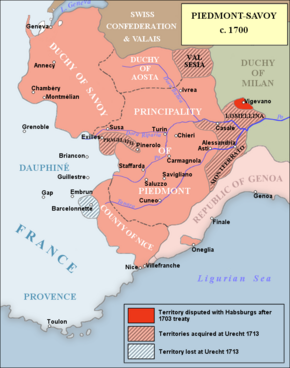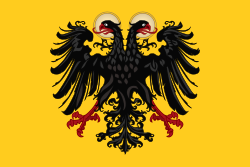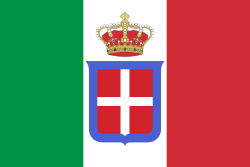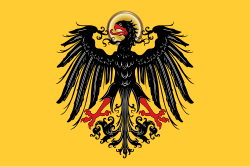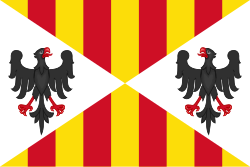Savojské státy
| Savojské státy États de Savoie (fr) Stati di Savoia (it) Sabaudia (la)
| |||||||||||||||||||||||||||
| Motto FERT | |||||||||||||||||||||||||||
Geografie
| |||||||||||||||||||||||||||
| Obyvatelstvo | |||||||||||||||||||||||||||
Počet obyvatel | 1.4 milionu (na konci 17. století) | ||||||||||||||||||||||||||
| Státní útvar | |||||||||||||||||||||||||||
| Státní útvary a území | |||||||||||||||||||||||||||
| |||||||||||||||||||||||||||
Savojské státy (francouzsky États de Savoie, italsky Stati di Savoia) jsou souhrnný název používaný historky pro svazek států Svaté říše římské ovládaných dynastií Savojských. Savojské území kdysi hrabat a později vévodů savojských se rozrostl o další přilehlé oblasti, z nichž největším byl Piemont (původně území Turínské marky). Z oblasti Savojska-Piemontu mohli Savojští dále expandovat a založit Sardinské neboli sardinsko-korsické království, které vzniklo 1847 „dokonalým spojením“ (fusione perfetta) všech držav savojské dynastie do jednoho politického celku, takže samotné Savojsko formálně zaniklo.
Přestože od počátku náleželi Savojští ke Svaté říši římské a tedy formálně podléhali císaři, nečinilo jim však překážky jednat v rozporu s říšskými zájmy a opakovaně se stavět na stranu Francie během francouzsko-habsburských válek.
Savojské státy se nacházely se na pomezí dnešních států Itálie, Francie a Švýcarska. Na Vídeňském kongresu roku 1815 jsou zmíněny jako „Státy Jeho Veličenstva krále Sardinie“. Savojští se později zasloužili o sjednocení Itálie a stali se italskými králi, zatímco země jejich původu Savojsko se stala regionem Francouzské republiky.
Seznam savojských států
|
Symbolika
- vlajka savojských států:
- zprvu hrabata užívali císařskou zástavu na znamení věrnosti k Říši
- vlajka hrabství a vévodství do roku 1783 odvozená ze znaku Savojských
- obchodní vlajka států v 18. století
- vlajka Sardinského království (1783–1802)
Reference
V tomto článku byl použit překlad textu z článku Savoyard state na anglické Wikipedii.
Externí odkazy
 Obrázky, zvuky či videa k tématu Savojské státy na Wikimedia Commons
Obrázky, zvuky či videa k tématu Savojské státy na Wikimedia Commons
Média použitá na této stránce
Autor: Vlastní dílo, Ronald Preuss (eagle), Licence: CC BY-SA 4.0
Royal banner (Königsbanner) of the German kings and emperors in the early to mid 14th century. The upright rectangular shape of the field approximates the proportions of 14th-century military banners, see e.g. File:Codex Balduini Trevirensis - Alpenüberquerung Heinrich VII.JPG
Autor: F l a n k e r, Licence: CC BY-SA 2.5
Flag of the Kingdom of Sardinia (1851-1861) and of the Kingdom of Italy (1861-1946). Use: Civil flag and ensign. In a governmental or a military context, the crowned version (see Crowned version) was always used (as State flag and naval ensign).
State Flag of the Savoyard States (late 16th - late 18th century).
Autor: David Liuzzo, eagle by N3MO, Licence: CC BY-SA 3.0
Banner of the Holy Roman Empire, double headed eagle with halos (1400-1806)
Autor: F l a n k e r, Licence: CC BY-SA 2.5
Při zobrazení tohoto souboru lze snadno přidat orámování
Autor: Dekodrak, Licence: CC BY-SA 4.0
Flag of the Marquisate of Saluzzo.
Autor: MostEpic, Licence: CC BY-SA 4.0
Coat of arms of the house of Savoy (Ancient)
Autor: Patricia.fidi, Licence: CC0
Flag of the County of Nice in France
Flag of the region Savoie in France
Autor: Pce13, Licence: CC BY-SA 4.0
Armoiries attribuées au Royaume d'Arles par des héraldistes médiévaux (XVe s.) ː "D'or à deux pals de gueule".
War Ensign of the Kingdom of Sardinia
State Flag and War Ensign of the Kingdom of Sardinia (1816-1848).
Flag of the Kingdom of Sardinia/Piedmont, XVIII century.
Flag of the Republic of Alba (1796-1801)
Autor: Facquis, Licence: CC BY-SA 4.0
Grande stemma del Regno di Sardegna dal 1815 al 1831
Lands of Victor Amadeus II, Duke of Savoy.
Autor: Samhanin, Licence: CC BY-SA 4.0
Flag of the Republic of Asti (1797)
Anachronistic representation of the royal banner of the 12th(?) or 13th to early 15th centuries.
The banner of this period would be square in shape, and the eagle would not have a halo.
The black eagle in a golden field was the ensign of the German kings (as opposed to the emperor) in the 12th and 13th century, but in the 14th century, it was gradually re-interpreted as representing the empire. An early reference to such a banner as "imperial" is made in an account of the burial of Charles IV (d. 1378), as der schwartz adler des richs in einem guldin veld .Flag of Genoa
Při zobrazení tohoto souboru lze snadno přidat orámování
Autor: Manny Mannheimer, Licence: CC BY-SA 4.0
Merchant Flag of the Savoyard states (18th century)


